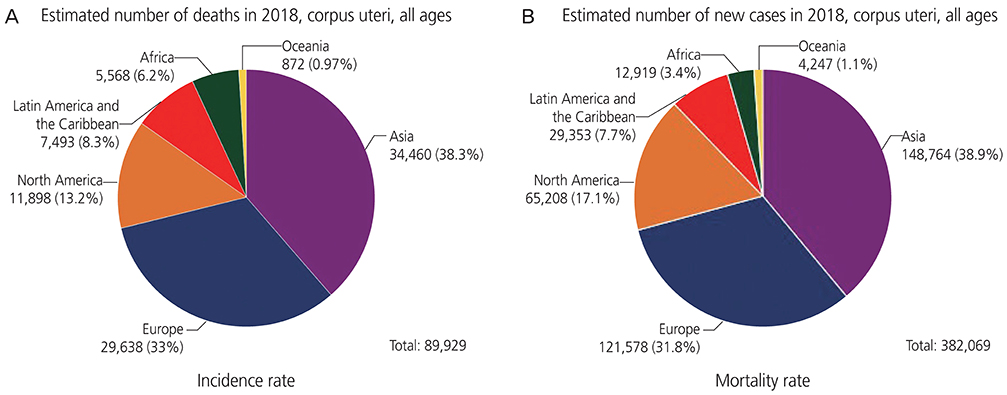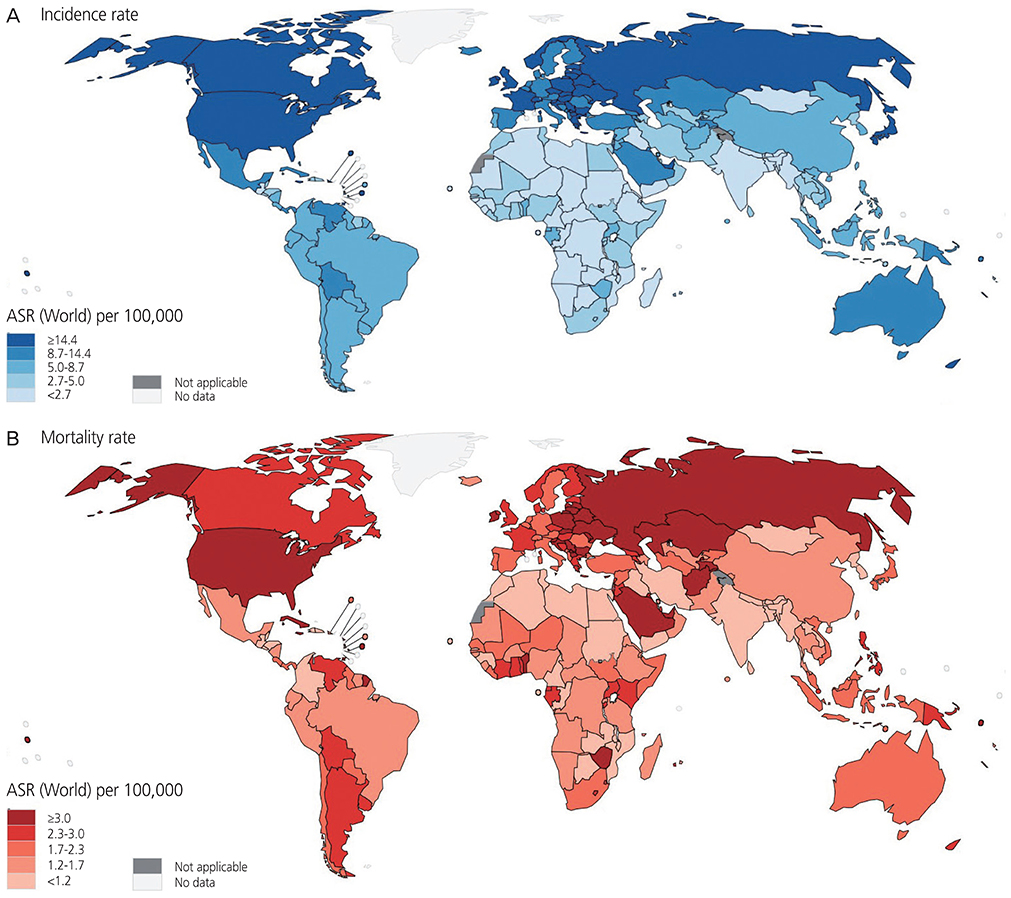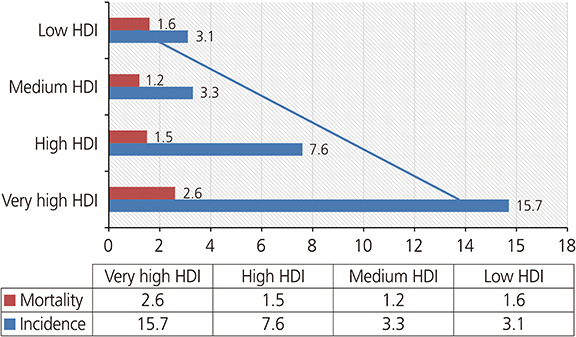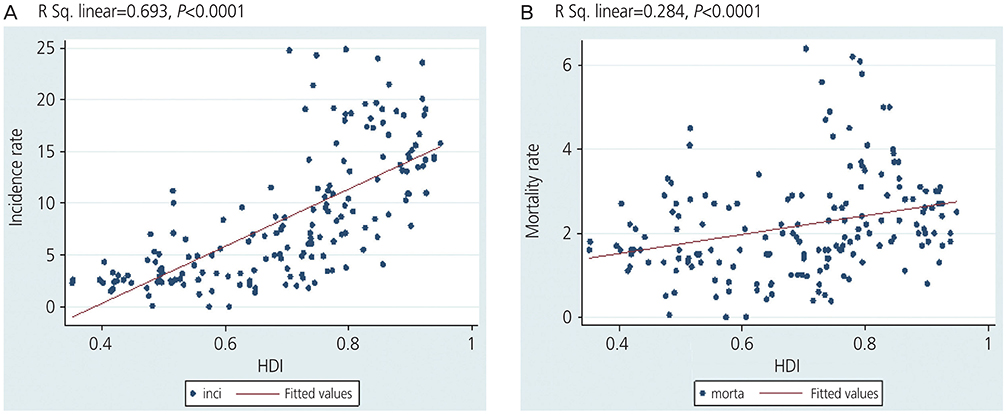Obstet Gynecol Sci.
2020 Mar;63(2):141-149. 10.5468/ogs.2020.63.2.141.
Association between the incidence and mortality rates for corpus uteri cancer and human development index (HDI): a global ecological study
- Affiliations
-
- 1Department of Epidemiology, School of Public Health, Ilam University of Medical Sciences, Ilam, Iran.
- 2Department of Public Health, School of Public Health, Social Determinants of Health Research Center, Lorestan University of Medical Sciences, Khorramabad, Iran.
- 3Department of Public Health, School of Medicine, Dezful University of Medical Sciences, Dezful, Iran.
- 4Iranian Research Center on Healthy Aging, Sabzevar University of Medical Sciences, Sabzevar, Iran.
- 5Department of Biostatistics and Epidemiology, School of Medicine, Zanjan University of Medical Sciences, Zanjan, Iran. kamyarmansori@yahoo.com
- KMID: 2471751
- DOI: http://doi.org/10.5468/ogs.2020.63.2.141
Abstract
OBJECTIVE
The aim of this study was to determine the association between the incidence of and mortality due to corpus uteri cancer (CUC) and the human development index (HDI) across the world.
METHODS
This was an ecological study. The incidence and mortality rates of CUC along with HDI data were extracted from the Global Cancer Data in 2018. Subsequently, correlation coefficient and linear regression model were used to determine the association between the incidence and mortality rates of CUC and the HDI. STATA-14 was used for data analysis.
RESULTS
There was a positive and significant correlation between the incidence (r=0.693; P<0.001) and mortality (r=0.284; P<0.001) rates of uterine cancer and the HDI. A positive and significant correlation was also observed between the incidence rate and the gross national income per 1,000 capita (r=0.440; P<0.001), mean years of schooling (MYS) (r=0.740; P<0.001), life expectancy at birth (LEB) (r=0.590; P<0.001), and expected years of schooling (r=0.650; P<0.001). The results of the linear regression model showed a significant statistical association between MYS and the incidence of CUC (β=1.10; 95% confidence interval [CI], 0.60-1.70) and LEB and mortality due to uteri cancer (β=0.40; 95% CI, 0.10-0.90).
CONCLUSION
The results of this study suggest a significant statistical association between the incidence and mortality rates of CUC and the HDI.
Keyword
MeSH Terms
Figure
Cited by 1 articles
-
Prophylactic tranexamic acid to reduce blood loss and related morbidities during hysterectomy: a systematic review and meta-analysis of randomized controlled trials
Ahmed Abu-Zaid, Saeed Baradwan, Ehab Badghish, Rayan AlSghan, Ahmed Ghazi, Bayan Albouq, Khalid Khadawardi, Nora F AlNaim, Latifa F AlNaim, Meshael Fodaneel, Fatimah Shakir AbuAlsaud, Mohammed Ziad Jamjoom, Abdullah AMA Almubarki, Saud Owaimer Alsehaimi, Safa Alabdrabalamir, Osama Alomar, Ismail A. Al-Badawi, Hany Salem
Obstet Gynecol Sci. 2022;65(5):406-419. doi: 10.5468/ogs.22115.
Reference
-
1. Alghamdi IG, Hussain II, Alghamdi MS, El-Sheemy MA. The incidence rate of corpus uteri cancer among females in Saudi Arabia: an observational descriptive epidemiological analysis of data from Saudi Cancer Registry 2001–2008. Int J Womens Health. 2014; 6:141–147.2. Santos P, Cunha TM. Uterine sarcomas: clinical presentation and MRI features. Diagn Interv Radiol. 2015; 21:4–9.
Article3. Siegel RL, Miller KD, Jemal A. Cancer statistics, 2015. CA Cancer J Clin. 2015; 65:5–29.
Article4. Ferlay J, Soerjomataram I, Dikshit R, Eser S, Mathers C, Rebelo M, et al. Cancer incidence and mortality worldwide: sources, methods and major patterns in GLOBOCAN 2012. Int J Cancer. 2015; 136:E359–E386.
Article5. American Cancer Society. Cancer facts & figures 2013. Atlanta (GA): American Cancer Society;2013.6. Mansori K, Khateri S, Moradi Y, Khazaei Z, Mirzaei H, Hanis SM, et al. Prevalence of obesity and overweight in Iranian children aged less than 5 years: a systematic review and meta-analysis. Korean J Pediatr. 2019; 62:206–212.
Article7. Friedenreich CM, Neilson HK, Lynch BM. State of the epidemiological evidence on physical activity and cancer prevention. Eur J Cancer. 2010; 46:2593–2604.
Article8. Cust AE. Physical activity and gynecologic cancer prevention. Recent Results Cancer Res. 2011; 186:159–185.
Article9. Bray F, Ferlay J, Soerjomataram I, Siegel RL, Torre LA, Jemal A. Global cancer statistics 2018: GLOBOCAN estimates of incidence and mortality worldwide for 36 cancers in 185 countries. CA Cancer J Clin. 2018; 68:394–424.
Article10. Chaichian S, Khateri S, Moradi Y, Shadmani FK, Mansori K, Khazaei Z, et al. Trends in cervical cancer incidence in Iran from 2003 to 2009. Middle East J Cancer. 2017; 9:57–63.11. Torres-Cintrón M, Ortiz AP, Ortiz-Ortiz KJ, Figueroa-Vallés NR, Pérez-Irizarry J, Díaz-Medina G, et al. Using a socioeconomic position index to assess disparities in cancer incidence and mortality, Puerto Rico, 1995–2004. Prev Chronic Dis. 2012; 9:E15.
Article12. Ghoncheh M, Mohammadian-Hafshejani A, Salehiniya H. Incidence and mortality of breast cancer and their relationship to development in Asia. Asian Pac J Cancer Prev. 2015; 16:6081–6087.
Article13. Goodarzi E, Moslem A, Feizhadad H, Jarrahi AM, Adineh HA, Sohrabivafa M, et al. Epidemiology, incidence and mortality of thyroid cancer and their relationship with the human development index in the world: an ecology study in 2018. Adv Hum Biol. 2019; 9:162–167.14. Trinh QD, Schmitges J, Sun M, Sammon J, Shariat SF, Zorn K, et al. Morbidity and mortality of radical prostatectomy differs by insurance status. Cancer. 2012; 118:1803–1810.
Article15. Davoodi M, Bahadoram S, Bahadoram M, Barahman M, Khazaei Z, Amiri M. Impact of cancers on the kidney function and structure; an ignored entity. J Renal Inj Prev. 2018; 7:112–115.
Article16. Goodarzi E, Ghorat F, Mosavi Jarrahi A, Adineh HA, Sohrabivafa M, Khazaei Z. Global incidence and mortality of liver cancers and its relationship with the human development index (HDI): an ecology study in 2018. World Cancer Res J. 2019; 6:e1255.17. International Agency for Research on Cancer. GLOBOCAN 2018. Lyon: International Agency for Research on Cancer;2018. cited 2018 Jan 17. Available from: http://gco.iarc.fr/today/datasources-methods.18. Khazaei Z, Ghorat F, Jarrahi AM, Adineh HA, Sohrabivafa M, Goodarzi E. Global incidence and mortality of skin cancer by histological subtype and its relationship with the human development index (HDI); an ecology study in 2018. World Cancer Res J. 2019; 6:e1265.19. Bray F, Jemal A, Grey N, Ferlay J, Forman D. Global cancer transitions according to the Human Development Index (2008–2030): a population-based study. Lancet Oncol. 2012; 13:790–801.
Article20. Khazaei S, Rezaeian S, Khazaei Z, Molaeipoor L, Nematollahi S, Lak P, et al. National Breast cancer mortality and incidence rates according to the human development index: an ecological study. Adv Breast Cancer Res. 2016; 5:30–36.
Article21. United Nations Development Programme. Human Development Report 2016. New York (NY): United Nations Development Programme;2016. cited 2018 Jan 17. Available from: http://www.hdr.undp.org/en.22. Khazaei Z, Mosavi Jarrahi A, Momenabadi V, Ghorat F, Adineh HA, Sohrabivafa M, et al. Global cancer statistics 2018: GLOBOCAN estimates of incidence and mortality worldwide stomach cancers and their relationship with the human development index (HDI). World Cancer Res J. 2019; 6:e1257.23. Banas T, Juszczyk G, Pitynski K, Nieweglowska D, Ludwin A, Czerw A. Incidence and mortality rates in breast, corpus uteri, and ovarian cancers in Poland (1980–2013): an analysis of population-based data in relation to socioeconomic changes. Onco Targets Ther. 2016; 9:5521–5530.24. Sankaranarayanan R, Ferlay J. Worldwide burden of gynaecological cancer: the size of the problem. Best Pract Res Clin Obstet Gynaecol. 2006; 20:207–225.
Article25. Zhang Y, Liu H, Yang S, Zhang J, Qian L, Chen X. Overweight, obesity and endometrial cancer risk: results from a systematic review and meta-analysis. Int J Biol Markers. 2014; 29:e21–9.
Article26. Khazaei Z, Hasanpour Dehkordi A, Amiri M, Adineh HA, Sohrabivafa M, Darvishi I, et al. The incidence and mortality of endometrial cancer and its association with body mass index and human development index in Asian population. World Cancer Res J. 2018; 5:e1174.27. Ferlay J, Steliarova-Foucher E, Lortet-Tieulent J, Rosso S, Coebergh JW, Comber H, et al. Cancer incidence and mortality patterns in Europe: estimates for 40 countries in 2012. Eur J Cancer. 2013; 49:1374–1403.
Article28. Jamison PM, Noone AM, Ries LA, Lee NC, Edwards BK. Trends in endometrial cancer incidence by race and histology with a correction for the prevalence of hysterectomy, SEER 1992 to 2008. Cancer Epidemiol Biomarkers Prev. 2013; 22:233–241.
Article29. Wartko P, Sherman ME, Yang HP, Felix AS, Brinton LA, Trabert B. Recent changes in endometrial cancer trends among menopausal-age U.S. women. Cancer Epidemiol. 2013; 37:374–377.
Article30. Kuehn B. Uterine Cancer Concern. JAMA. 2019; 321:336.
Article31. Lindemann K, Vatten LJ, Ellstrøm-Engh M, Eskild A. Body mass, diabetes and smoking, and endometrial cancer risk: a follow-up study. Br J Cancer. 2008; 98:1582–1585.
Article32. Dossus L, Allen N, Kaaks R, Bakken K, Lund E, Tjonneland A, et al. Reproductive risk factors and endometrial cancer: the European prospective investigation into cancer and nutrition. Int J Cancer. 2010; 127:442–451.
Article33. Renehan AG, Soerjomataram I, Tyson M, Egger M, Zwahlen M, Coebergh JW, et al. Incident cancer burden attributable to excess body mass index in 30 European countries. Int J Cancer. 2010; 126:692–702.
Article34. Shields M, Connor Gorber S, Tremblay MS. Estimates of obesity based on self-report versus direct measures. Health Rep. 2008; 19:61–76.35. Momenimovahed Z, Ghoncheh M, Pakzad R, Hasanpour H, Salehiniya H. Incidence and mortality of uterine cancer and relationship with human development index in the world. Cukurova Med J. 2017; 42:233–240.
- Full Text Links
- Actions
-
Cited
- CITED
-
- Close
- Share
- Similar articles
-
- Epidemiology and Inequality in the Incidence and Mortality of Nasopharynx Cancer in Asia
- The Relationship Between Obesity, Overweight, and the Human Development Index in World Health Organization Eastern Mediterranean Region Countries
- Prevalence of iron deficiency anemia in Asian female population and human development index (HDI): an ecological study
- Global Trends in Childhood Sexual Abuse and Bullying Victimization in 204 Countries: A Comprehensive Analysis From 1990 to 2019
- Survival of gynecological cancers in Turkey: where are we at?





